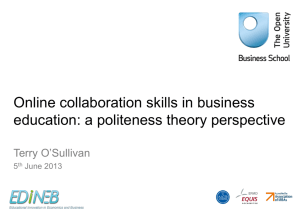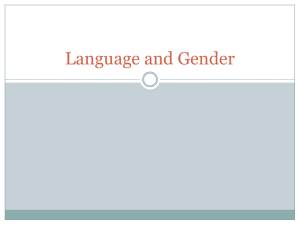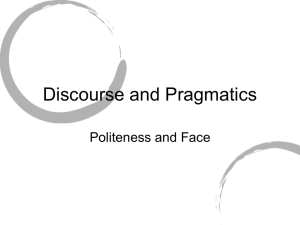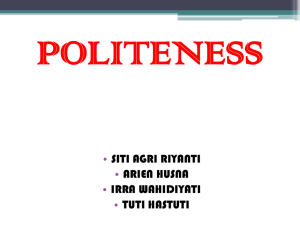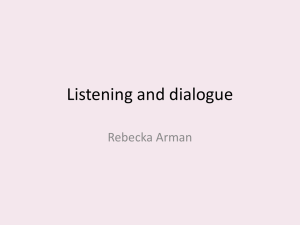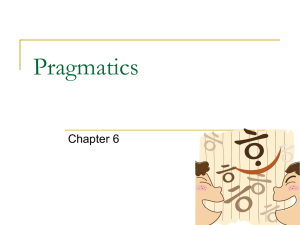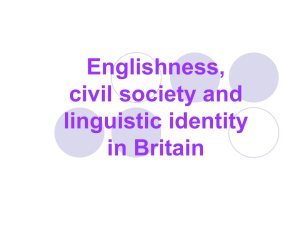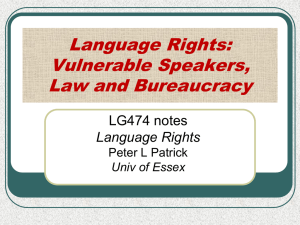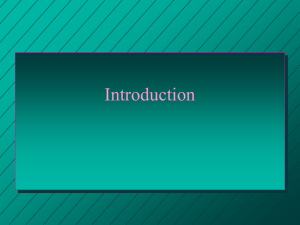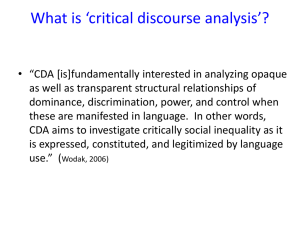Speech Acts
advertisement
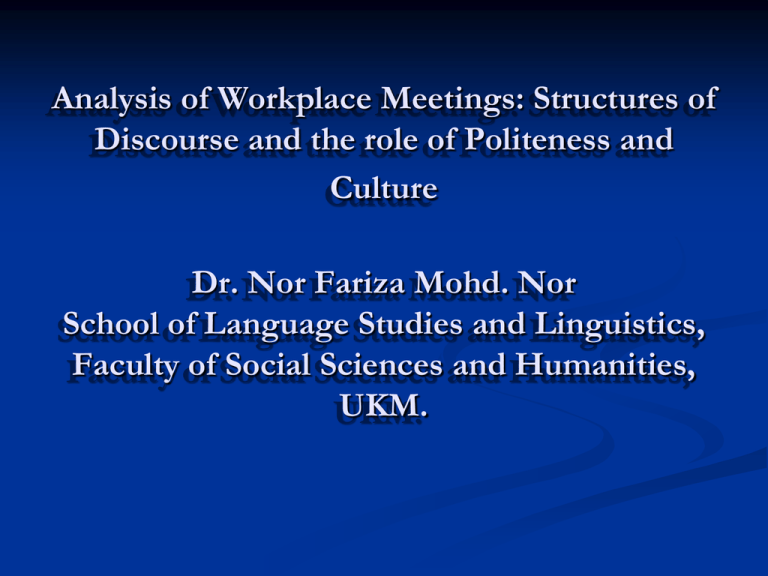
Analysis of Workplace Meetings: Structures of Discourse and the role of Politeness and Culture Dr. Nor Fariza Mohd. Nor School of Language Studies and Linguistics, Faculty of Social Sciences and Humanities, UKM. Structure Background to the study Research questions Methodology Framework of analysis – Speech acts, discourse strategies, politeness, culture Findings Conclusion Implication Background to the study Analysis of meetings discourse Data taken from observations of meetings in two organizations – organization A and organization B. Meeting in organization A – government-owned company incorporated under the Ministry of Finance 1. Participants – 10 2. Meeting agenda –standardization of device in cards Meeting in organization B – multinational company in consultancy services – business consultancy (executive recruitment, management assessment and mid-level recruitment services) 1. Participants – 3 2. Meeting agenda – consultancy services Research questions 1. What types of Speech Acts and discourse strategies were employed to display politeness? 2. Are these politeness traits reflective of the participants’ cultural background? Methodology Qualitative Observation and recording of the meetings. Meeting in organization A – almost two hours. Meeting in organization B- one hour. Transcription of the meetings Discourse analysis – eclectic approach – speech acts, discourse strategies, politeness strategies. Stage 1 Close examination of speaker-hearer response patterns Methodology Stage 2 Coding Identification of speech acts Identification of discourse strategies Examination of politeness strategies Examination of whether the politeness strategies reflected the cultural traits of the participants. Framework of analysis: Speech Acts Speech Acts Speech Act theory concerns “what people do with language” (Schiffrin, 1994: 90). In other words, the theory is concerned with the functions of utterances in interaction. Introduced by Austin (1962) – locutionary, illocutionary and perlocutionary act. Searle (1969) – modified Austin’s framework – proposed five categories based on their illocutionary point: 1. declarations – words & expressions that change the world by their very utterance; 2. representatives – the words state what the speaker believes to be the case; 3. commissives – the words commit the speaker to future action; Framework of analysis: Speech Acts 4. directives – the words are aimed at making the hearer do something. 5. expressives – the words state what the speaker feels. These five categories are considered in identifying the speech act form of the participants’ utterances. In discourse, however, speech acts function may overlap, or a speaker may have several intention in mind, thus an utterance can have more than one function. This means that speakers perform one illocutionary act explicitly while implying another. Framework of analysis: Speech Acts Speech Acts to establish purpose/objectives to express opinions to make suggestions to ask for clarification to request for information to express agreement to express disagreement to seek agreement to justify argument/ disagreement Framework of analysis:Discourse strategies Van Djik (1983, 1997) - discourse strategies constitute a fundamental aspect of discourse. - links the use of discourse strategies with the realization of social and communicative goals. A strategy has to do with “various possible routes in a complete course of action in order to reach a wanted goal” (Van Djik, 1983: 11). Discourse strategies Rhetorical strategies – inductive and deductive Hedges Humour Topic control Questioning Repetition Framework of analysis: Politeness theory Brown and Levinson (1987)- SA are related to polite behaviour as face-saving strategies. Theory based on the concept of face as proposed by Goffman (1967) who defines face as an individual’s self image. Brown and Levinson define face as ‘wants’ and distinguish between positive face and negative face. Positive face is the desire to have one’s attributes and actions approved of by significant others. Negative face is the desire to maintain one’s autonomy and be free from unnecessary constraint. Framework of analysis: Politeness theory A particular strategy is chosen based on the assessment of whether it will involved risk of face loss in performing a specific Face Threatening Act (FTA). The risk is assessed by evaluating the relative value of three variables: 1. the social distance between the speaker and the hearer; 2. the relative power of hearer over speaker; 3. the relative ranking of the FTA in the cultural context concerned. Thomas (1995: 169) – FTAs are “illocutionary acts [that] damage or threaten another person’s face”. 1. Bald on record – direct and without redress. Used when the risk of face loss in performing FTA is low. 2. SA is abstained - if the risk of face loss in performing FTA is high, the speaker does not perform the SA. Framework of analysis: Politeness theory 3. Bald on record with negative politeness, with redress - the speaker avoids intruding into the hearer’s territory. 4. Bald on record with positive politeness, with redress - the speaker aims to save positive face, by demonstrating closeness and solidarity, by appealing to friendship and making other people feel good. 5. Off-record politeness strategy - the utterance is ambiguous, which means there is more than one possible interpretation for the utterance – this is indirectness of SA which gives the speaker a way out of FTA. The hearer, on the other hand, can choose not to understand the utterance. Framework of analysis: Politeness theory Brown and Levinson admits - the distinction between positive politeness and negative politeness is vague and in natural data, there are bound to be overlaps. Criticism - the concept of positive and negative face do not address the discourse behaviours of non-western cultures, such as Asian cultures - the interaction focus on collectivism or group identity rather than individualism (Matsumoto, 1989; Mao, 1994). Culture Malay culture – an important component of the Malay culture is the religion; consequently the beliefs, attitudes, perceptions and social behaviours of the Malays are strongly influenced by the teaching and tenets of the Islamic religion. Chinese culture – Buddhism and Taoism – with the underlying concepts of Confucianism. Indian culture – majority of the Indians are Hindus by religion. Malaysian values – common values – observation of politeness system that embodies specific codes of verbal and non-verbal behaviour in interaction with others. i. Respect for the elders ii. Hierarchy – consciousness of the social hierarchy in society – honorifics, correct salutations . Culture iii. Religion – most malaysians identify with a particular religion. This forms the foundation in guiding the conduct of a person’s behaviour. iv. Harmony – preserving each other’s face in interactions is very important in maintaining harmony and stability. To preserve harmony, the truth must not always be expressed openly and one has to find subtle ways to avoid conflict. Studies in Malaysian context (Abdul Aziz Idris, 1991; Khadijah Ibrahim, 1993; Jamaliah Mohd. Ali, 2000; Suraiya Mohd. Ali, 2002; Baljit Kaur, 2002) Speech acts and politeness: Findings (1) Organization A RoCS1: We shall go through the minutes first er the previous minute before we invite comments from the group –to establish purpose - directive- instruction was direct and commanding. Politeness - Direct and bald on record – to assert his position and power as the chairperson of the meeting. Speech acts and politeness: Findings (2) RoCS1: Now item number four. In last meeting we decide what do you call that…the ..the.. status of the project pertaining to which part we want to er…adapt or not. Any comments? – Silence to seek agreement - representatives – ‘claiming’ and ‘describing’. Indirect SA – should not comment. This utterance restrict the action of the group members. The participants were constrained into agreeing with RoCS1 – solidarity politeness, to save RoCS1 face. Allowed RoCS1 to exercise power. RoCS1: No comments? I take it that everyone agrees. Ok we shall er proceed to the next item –to instruct - directive. Speech acts and politeness: Findings (3) Organization A CS5: Mr. Chairman, correct me if I’m wrong. I think the procedure will delay the standards issue. indirect SA, ‘to suggest’ - directives – aimed at making the hearer do something. Politeness - bald on record with negative politeness strategy – ‘correct me if I’m wrong’ – to show respect of the chair’s position. Minimise the imposition by using the mitigating device - “correct me if I’m wrong”. “I think”–displayed deference as it reflected CS5’s subordinate position. Speech acts and politeness: Findings (4) RoCS1: I see your point, but the procedure is important. We need to conduct it. We’re…the stakeholders and er we don’t want to jeopardize our position. to express agreement. ‘but’ indication of disagreement. To justify disagreement - representatives Politeness - bald on record with positive politeness strategy, with redresive action in order to redress his power enabled the SA to be carried out with no damage to the interaction despite the face threat involved. When he gave reason to support his disagreement, he tried to save CS5 positive face. The politeness strategy employed by RoCS1 tapped on the interplay of power with solidarity politeness – expressed through the use of the pronoun “we”. Speech acts and politeness: Findings (5) Organization B RHCS1: All aside the concern is how long you’ll stay? It’s important for us to know. to request for information - directives, direct with emphasis. Politeness strategy – direct and bald on record –to assert his power as the chairperson and the interviewer. Speech acts and politeness: Findings (6) JIS3: It’s difficult for me to tell. For sure I’m ready to move in the industry. It’ll be a challenge. I think if I’m comfortable working here I’ll stay…you know Indirect SA – ‘to suggest’ - the hearer appeared to avoid committing herself to a clear answer. The speaker tried to rationalize her reply - “I think if I’m comfortable working here I’ll stay…you know” – the speaker also used hedges. Politeness - off-record politeness strategy –the reply was ambiguous, which enabled JIS3 to be polite without threatening the hearer’s face (RHS1). The hearer can choose to ignore the utterance. Discourse strategies: Findings (1) Hedges - Hedges are identified as markers which comprises filled pauses – modal auxiliaries or utterances. Hedges are often used as a means to protect the speaker and the hearer’s face wants. Brown and Levinson (1987) classify hedges in the category of negative politeness. Organization B RHCS1: You seem to be very interested in the Asia Pacific region. SCLS2: Yes because I feel I could contribute a lot in that direction Discourse strategies: Findings (2) RHS1: I can see that you’re rather confident about it despite the fact that er… I mean you’re not so in touch with the local context “Yes because I feel I could contribute a lot in that direction” Modal auxiliary – ‘could’ used by SCLS2, as a strategy to mitigate FTA (of himself) in the event that his interest to work in the Asia pacific region might be ignored. SCLS2 is aware that he lacked the experience of working in the region although he has a strong interest to work in the region. Discourse strategies Findings (3) Politeness - bald on record with positive politeness - allowed SCLS2 to seek solidarity as the company does a lot of work in the Asia pacific region. “I can see that you’re rather confident about it despite the fact that er… I mean you’re not so in touch with the local context “ RHSC1 used ‘I mean’ to soften the effect of FTA - as a deference strategy. Politeness - bald on record with positive politeness in order to reduce FTA and save face of both RHSC1 and SCL2. Discourse strategies: Findings (4) Humour - considered a politeness strategy device used to establish solidarity between parties. Organization B RHCS1: So yes with the degree thing the possibility of you wanting to leave is there = JIS3: = But you know me very well. I’ll tell you if I intend to leave RHCS1: That’s what we’re scared of <laughter> In order to ease the tense atmosphere and to change the topic, RHCS1 uttered something which appeared humorous to JIS3 and TMDS2. Considered as solidarity politeness to reestablish rapport following the tense atmosphere. It was also a strategy to lessen the FTA for JIS3 and RHCS1. Discourse strategies: Findings (5) Humour – Organization A RoCS1: This crypto is the crypto engine within the card, kan (right)? KS10: It is the card crypto, but we don’t follow their standard. I don’t think we can adopt their standard because we already have ours. RoCS1: Well, you know better as engineer. But I think we can change. Nanti dia kata (They might say later) Malaysian banking card no standard pulak (well) <laughter> Code switch to Malay drew laughter. Strategy used by the chair effectively to subtly assert his power as well as to soften negative face threats of KS10. The use of humour also enhance the group’s solidarity as members of the meeting and members of the same organization. Conclusion (1) Speech acts used were primarily directives. Two instances of representatives. Direct and assertive – display power. Discourse strategies Hedges were found to be used as strategy to soften face threatening acts or to enhance solidarity. Humor was effectively used by superiors to downplay power distance, soften negative face threats such as directives, or enhance solidarity. (Holmes, 2000). Conclusion (2) Politeness The politeness strategy used were for the purpose of attending to the goals of the speaker and the hearer. The politeness strategy extended the support to both the hearer and the speaker in order to minimize FTAs. Face support protected the harmonious relationship between the speaker and the hearer. The participants in the meetings were receptive to the information presented by the other, and into being accomodative and adaptable to each other’s wants and concerns. Conclusion (3) Both the superior and the subordinate parties displayed politeness to express deference and solidarity. Cultural orientation The majority of participants in the meeting in organization A are Malays. While the participants in the meeting in organization B are Malay (RHS1, the CEO of the company) and Chinese (TMDS2, the managing director; JIS3 and SCLS2 (the clients). The notion of individualism, which Brown and Levinson’s theory is built on is not fully applicable. Conclusion (4) Asian cultural orientation is towards collectivism, instead of individualism. The cultural traits of the participants with respect to politeness reflect the cultural orientation for relational harmony, for both Malays and Chinese. The interplay of indirect speech act and politeness in the interaction showed emphasis for relational harmony in achieving goals. Power was exercised with redress and politeness by the Chairperson in the meetings. Direct speech act was displayed in order to establish purpose at the beginning of the meeting and to proceed with the meeting (RoCS1). Conclusion (5) JIS3 (meeting in organization B)– was adamant about not giving the expected answer. However, this was done using off record politeness strategy, which allowed JIS3 to be ambiguous in order to avoid threatening the chairperson’s face. Thomas (1995) - Altering another person’s behavior inherently is face threatening; consequently, individuals use politeness to balance their competing desires to be clear about what they want and to support their interaction partner’s face. Implications 1. 2. 3. In order to achieve the goals of a meeting successfully – be receptive, accommodative and adaptable. Participants must be receptive to the information given to each other in order to facilitate the attitude of being adaptable and accommodative of each other’s wants and concerns. Politeness appear to be an essential tool for fulfilling goals in meetings. This has implications for intercultural encounters – giving deference and emphasizing solidarity politeness can foster relational harmony between participants. The universality for politeness as face-saving device (the concept of politeness by Goffman, Brown and Levinson, which presumed that individuals in all cultures desire to maintain face) – can be used as a tool to facilitate interaction in intercultural communication. THANK YOU
